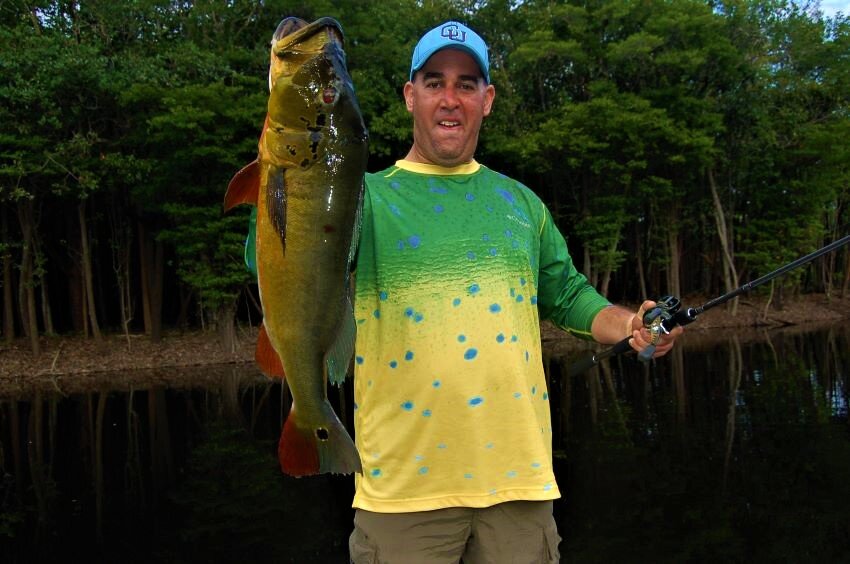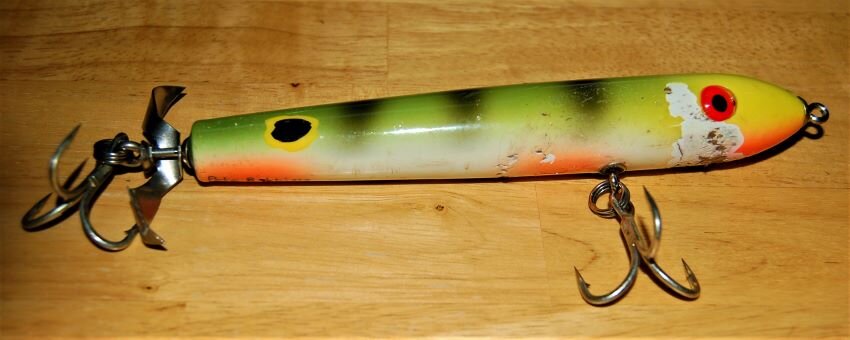Peacock Bass Questions You Were Afraid to Ask – Everything Explained
For many adventurous anglers, and bass fishermen in particular, peacock bass are a holy grail species. They live in remote regions, grow big, eat oversized topwaters and fight like hell. Because so many of our friends have either chased them or expressed an interest in heading to one of Brazil’s Amazon lodges south of the equator to catch them, we’ve published multiple blog entries about this amazing tropical species.
What we’ve realized, though, is that some readers might not understand what all of the fuss is about. They might hear the name “peacock bass,” and know that it’s a highly-desired target and nothing more—but because everyone else is so jazzed up about them they’re afraid to ask “dumb questions.”
We’re here to answer those questions.
We’re not experts, but we’ve taken four trips where peacocks were either the primary target or a close second — our first trip was in the USA, and that was a gateway drug to going peacock bass fishing in Brazil. Furthermore, we’ve read all about them, watched just about every YouTube video featuring them, and we’ve talked to many other peacock bass addicts. Here’s some of the basis info you might want to know.
How are peacock bass related to largemouth and smallmouth bass?
Peacock bass are not bass. They are cichlids, essentially giant aquarium fish. Indeed, Barcelos, Brazil, the launch point for many trips into the Amazon, is considered one of the world’s hotspots for gathering tropical fish. We nevertheless call them bass because they exhibit many of the same sportfish qualities as bass. Actually, largemouth and smallmouth bass are not “true bass,” either. They are actually big members of the sunfish family.
Why do I want to catch a peacock bass?
Peacock bass often have gorgeous markings. They strike hard and fight even harder. They often live in beautiful places. If you enjoy shallow water “combat” fishing, this is a species that should be on your bucket list.
What is the closest place I can catch peacock bass?
The great news is that you can catch peacock bass in the United States. If you live in the lower 48, the closest place is likely the canals and lakes of South Florida. Peacock bass cannot survive cold water temperatures, so they typically do not live above Palm Beach County, but there are solid fisheries along both the east and west sides of the state—most notably but not exclusively in the canals of Miami. There are numerous guides who will take you fishing for them. Indeed, that was how we first chased the species in 2010. However, you don’t necessarily need a guide or a boat to chase and catch them. There are many places you can easily and legally fish for them off of the bank. They are the “Butterfly” species, which don’t grow huge down there, perhaps up to about 10 pounds, but they are plentiful and accessible.
How did peacock bass get to Florida?
The State of Florida introduced them in the 1980s as a means of controlling illegally-introduced aquarium fish and also to provide a sport fishing opportunity for local anglers.
Are there places in the USA besides Florida where I can catch peacock bass?
Because they don’t tolerate even brief periods of cold water, there aren’t many places in the United States that they can survive. Florida is the only option in the Lower 48, but there are also populations in Hawaii on Oahu and Kauai. You can also catch them in Puerto Rico.
What International Locations Have Peacock Bass?
Brazil is perhaps the best known foreign destination for peacocks. It encompasses a huge swath of the Amazon and its tributaries and has a vibrant sportfishing infrastructure and community. For many years Lake Guri in Venezuela was also a popular destination for big peacocks, but political pressures shut that down for travelers from many other countries. There are other established peacock bass fisheries in Colombia, Guiana, Suriname and Bolivia, among others.
So it’s just South America?
No. Many anglers get their introduction to peacocks at Lake Gatun in Panama, where it’s possible to catch huge numbers of smaller specimens in a day. We know of many anglers heading to Panamanian saltwater destinations who add this onto their trip. Additionally, many members of the US military stumble onto this fishery while stationed in Panama.
OK, so peacock bass just live in the Americas?
Again, no. There is a substantial population of trophy peacocks in Singapore, although they may be difficult to access. Nevertheless, an active fishing community has formed around them. There are also reports of them showing up in other countries, including Australia, but there’s never been any confirmation of a sustained population.
If I want to fish in Brazil do I fly through Rio or Sao Paolo or Brasilia?
Likely none of the above. Since the main fisheries are north of there, closer to the equator, the most logical gateway is Manaus in the State of Amazonas. From there you may have to take a regional plane or charter (often a float plane) to your eventual destination. Manaus is a safe and modern city, although in recent years flights have been limited from the United States for a variety of reasons.
Can I drive to Manaus from one of Brazil’s other major cities?
While Manaus was the capital of the rubber trade in the 1800s, and therefore has many modern amenities, it is isolated by the harsh terrain around it. Accordingly, there are no roads into the city from other major parts of the country. You will need to come in by air or by water.
Are peacock bass good to eat?
The smaller peacock bass are remarkably good to eat, with white, flaky meat. On many trips into the jungle the guides will build a campfire at lunchtime and cook peacocks for you, then set up hammocks for a brief nap. We’ve also really enjoyed other Amazonian fish including piranhas and tambaqui.
Am I likely to catch other fish while trying to catch peacock bass?
Peacock bass tend to live in very fertile ecosystems. In Florida, for example, you never know whether you’ll catch a peacock, another type of cichlid, a largemouth bass, or even a tarpon or snook. The Amazon has countless other species in its tributaries, many of which fight just as hard and grow even bigger than peacocks. We’ve caught piranhas, arowana, jacunda, wolf fish, payara and others. We also really want to chase arapaima.
Are there more than one kind of peacock bass?
The most common species that sportfishermen chase are the smaller butterflies as well as the cichla temensis, which depending on whether they’re spawning may either take on speckled (aka, Paca) or three-bar (aka, Acu) coloration. There are numerous others. One that we’re really anxious to catch is the Blue (Azul) peacock that our Brazilian friend Alex Koike told us about.
What are some of the classic ways to catch peacock bass?
The classic image that sticks in many bass anglers’ minds is a peacock exploding on a fast-moving oversized topwater prop bait. That’s how Hanna caught her two biggest fish, and how I caught my second biggest. We’ve also caught them on a variety of other lures, including walk-the-dog topwaters, jerkbaits and spoons. I caught my biggest peacock, a 21-pound Paca, swimming a red and yellow hair jig. The jig is typically one of the best ways to catch numbers of fish, too. As with all lures, make sure it has a stout hook. Fly fishing is also an excellent way to catch peacocks, and on our first fishing trip to Brazil in 2011 the lone fly angler in our group caught many more fish than the rest of us, although no big ones. Many avid peacock bass fishermen in Florida use live shiners for pressured fish.
What is the most exciting way to catch peacock bass?
While the topwater bite is exceptional, and tough to beat, for me the most exciting way to catch them is bushwhacking into a backwater lagoon in Brazil. When the water gets high, the fish will swim into these small “lakes” and then when the water level drops out they’ll effectively be stuck there. The guides will use a machete or even a chainsaw to get you to these virgin locales, and if you find one with a healthy population of stranded fish, they can be ravenous.
Do I need any special tackle to catch peacock bass?
The nice thing about chasing peacocks is that you can use bass tackle that you likely already own. We tried 300-sized reels on our first trip to Brazil but found the 150 and 200s to be more palatable to cast all day. A 6’6” to 7’ medium-heavy or heavy rod will do the trick. You’ll need one to handle the larger prop baits and another that can fling a jerkbait or ½ ounce jig. Because you’ll be working your lures aggressively, lightweight durability is critical. I recommend a high-speed reel because peacocks seem to very much prefer lures that are retrieved exceptionally quickly. Spool it up with 50- to 80-pound test braided line. The former casts better, the latter will hold up better to abrasion-causing surfaces.
What is that hump on their head?
Mature males grow a pronounced hump on their heads during the spawning process.
How do they protect their fry?
Peacocks spawn on a bed or nest like largemouths and smallmouths but once the fry are big enough to leave the parents continue to guard them. When attacked, the male will temporarily suck the babies into his mouth for safekeeping. If you see a group of bubbles on the surface in the middle of a lagoon, that’s often a fry-guarder. Make a quick cast just past them, bring it through, and you’re likely to get wrecked.
Do they have teeth?
In my limited experience, peacocks have a powerful, scratchy lower lip, so you can’t really lip the bigger specimens like you would a largemouth. For that reason, and also because the fish are so powerful, most South American outfitters use a Boga Grip for hook removal and pictures. Be careful of their gill rakers, which are extremely sharp. I made the mistake of putting a hand in there ONCE…never again. Also note that most other fish you catch around peacocks in the Amazon do have teeth or some other way of hurting you.
Do they have any other names?
You may also hear peacocks called tucunaré or the Spanish generic pavόn.
Can I take one home and get it mounted?
It’s going to be tough to get a properly-preserved peacock home from a foreign country, and even if you’re in Florida and close to the taxidermist, we think that skin mounts are a concept whose time has passed. Fiberglass replicas are not only just as realistic, with a conservation benefit, but they last much longer and better than the “real thing.” We have replicas of two of our biggest that we got from Advanced Taxidermy in Canada in a prime space in our living room. We also have another jungle species from them, the payara, and hope to add more to the collection. The peacocks still look new a decade after we got them, requiring just an occasional dusting.
If you’d like to take a trip to the Amazon — with or without us — shoot us an email and we can hook you up with a premier floating lodge to get you where the giants live.










